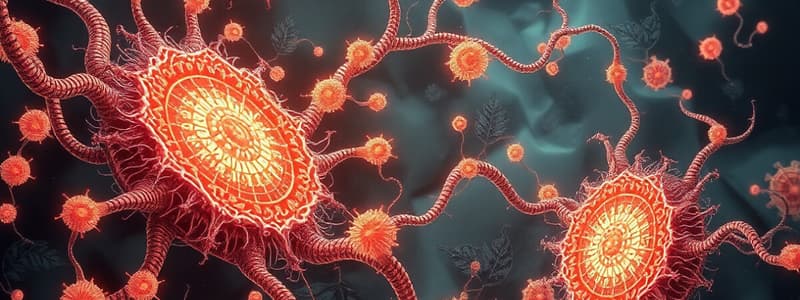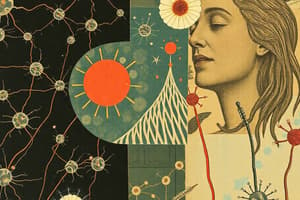Podcast
Questions and Answers
تستطيع الخلية العيش منعزلة عن غيرها.
تستطيع الخلية العيش منعزلة عن غيرها.
False (B)
ما هى وظائف الإشارات في الخلية؟
ما هى وظائف الإشارات في الخلية؟
تُستخدم الإشارات لتوصيل المعلومات من خلية إلى أخرى أو من جزء لآخر من الخلية نفسها.
ما هي أنواع التواصل بين الخلايا؟
ما هي أنواع التواصل بين الخلايا؟
- التواصل المباشر (correct)
- التواصل غير المباشر (correct)
- كل ما سبق (correct)
- لا شيء مما سبق
Flashcards
التواصل الخلوي
التواصل الخلوي
النظام الحيوي الذي يمكّن الخلايا من الاستجابة للبيئة المحيطة، من خلال التواصل بين الخلايا أو داخلها.
الخلية المرسلة
الخلية المرسلة
خلية تُنتج وتطلق جزيئات الإشارة.
الخلية المستهدفة
الخلية المستهدفة
خلية تتلقى جزيئات الإشارة وتستجيب لها.
جزيء الإشارة
جزيء الإشارة
Signup and view all the flashcards
التواصل الخلوي المباشر
التواصل الخلوي المباشر
Signup and view all the flashcards
التواصل الخلوي المباشر من خلال الالتحام
التواصل الخلوي المباشر من خلال الالتحام
Signup and view all the flashcards
التواصل الخلوي المباشر من خلال الوصلات الفجوية
التواصل الخلوي المباشر من خلال الوصلات الفجوية
Signup and view all the flashcards
التواصل الخلوي غير المباشر
التواصل الخلوي غير المباشر
Signup and view all the flashcards
التواصل الغدي
التواصل الغدي
Signup and view all the flashcards
التواصل المحلي
التواصل المحلي
Signup and view all the flashcards
التواصل العصبي
التواصل العصبي
Signup and view all the flashcards
التواصل الذاتى
التواصل الذاتى
Signup and view all the flashcards
التأثير الخلوي
التأثير الخلوي
Signup and view all the flashcards
خطوات التواصل الخلوي
خطوات التواصل الخلوي
Signup and view all the flashcards
مراحل التأثير الخلوي
مراحل التأثير الخلوي
Signup and view all the flashcards
الاستقبال
الاستقبال
Signup and view all the flashcards
النقل
النقل
Signup and view all the flashcards
الاستجابة
الاستجابة
Signup and view all the flashcards
الرسول الثاني
الرسول الثاني
Signup and view all the flashcards
بروتينات الإشارة
بروتينات الإشارة
Signup and view all the flashcards
المحاكيات
المحاكيات
Signup and view all the flashcards
المستقبل
المستقبل
Signup and view all the flashcards
الخلايا والتحكم في نشاط البروتينات
الخلايا والتحكم في نشاط البروتينات
Signup and view all the flashcards
التضخيم
التضخيم
Signup and view all the flashcards
إنهاء الإشارة
إنهاء الإشارة
Signup and view all the flashcards
عدم الحساسية
عدم الحساسية
Signup and view all the flashcards
التغيير في شكل الخلية أو حركتها
التغيير في شكل الخلية أو حركتها
Signup and view all the flashcards
التغيير في عملية التمثيل الغذائي
التغيير في عملية التمثيل الغذائي
Signup and view all the flashcards
التغيير في تعبير الجينات
التغيير في تعبير الجينات
Signup and view all the flashcards
الترابط بين مسارات الإشارة
الترابط بين مسارات الإشارة
Signup and view all the flashcards
Study Notes
Membranes & Transport (040817305) & Cell Signalling
- Cells do not exist in isolation; even unicellular organisms respond to external stimuli (chemicals, light, other cells).
- In multicellular organisms, complex interactions between cells (tissues & organs) are crucial for coordinated functioning.
- Cells continuously send and receive information (signals).
- Information is relayed within cells to generate responses.
Why Do Cells Communicate?
- To release and produce hormones and other regulatory molecules.
- To maintain metabolic activities.
- To control cell growth, division, development, differentiation, and death.
- To facilitate DNA repair.
- To maintain inflammation and immunity.
- To adapt to environmental conditions.
Key Steps in Cellular Signaling
- Signal Transmission: Synthesis, release, and transportation of signaling molecules from the signaling cell to the target cell.
- Intracellular Signaling:
- Reception: Recognizing and detecting the ligand by the target cell.
- Transduction: Chain of reactions initiated after reception, activating downstream molecules.
- Response: Initiation of a biological response (inhibitory or excitatory) by target cells. Signals ultimately lead to a cellular response.
- Signal Removal & Termination: The signal molecule leaves the receptor, reversing it to its inactive state.
Modes of Signaling Transmission
-
Direct Cell-Cell Signaling (Contact Dependent):
- Juxtacrine Signaling: Direct interaction of interacting membrane proteins on two different cells. Critical to immune system development and activity.
- Gap Junctions: Special cell-cell junctions connecting the cytoplasm of adjacent cells, enabling small signaling molecules or ions to diffuse between cells.
-
Indirect Cell-Cell Signaling (Distant):
- Distant (Endocrine) Signaling: Signal molecules (hormones) produced by distant endocrine cells (endocrine glands) but affect other parts of the body at a distance.
- Hormones travel through the bloodstream to target cells.
- Hormones have a slower response but longer-lasting effects.
- Hormones can derive from amino acids or lipids.
- Distant (Endocrine) Signaling: Signal molecules (hormones) produced by distant endocrine cells (endocrine glands) but affect other parts of the body at a distance.
-
Indirect Cell-Cell Signaling (Local):
-
Paracrine Signaling: Signal molecules released by signaling cells diffuse locally, binding to receptors on nearby target cells
-
Autocrine Signaling: Ligands produced by signaling cells bind to receptors on the same cell or neighboring cells of the same type. Important in embryonic development, pain sensation and inflammatory responses.
-
Neuronal (Synaptic) Signaling: Signaling molecules (neurotransmitters) are produced by neurons transferred to target cells (neurons or muscle cells). Fast response by moving electrical impulses in the nerve cells. Brief duration of signal because neuro-transmitters are quickly removed or deactivated.
-
Intracellular Signaling
- The process of transmitting molecular signals from outside the cell into the cell; results in intracellular changes.
- Involves a cascade of intracellular biochemical changes, primarily through ligand binding to receptor proteins.
- Key players include signaling molecules (ligands), receptors, second messengers, and signaling proteins (adaptors, amplifiers, transducers, integrators, etc.).
Signal Transduction Pathways
- Not simple chains, but highly complex and multi-step branched networks.
- Different cell types have unique protein profiles, resulting in variations in detected signals & responses.
Different Responses to the Same Signaling Molecule
- The same signaling molecule can evoke different responses in different cell types due to variations in receptors and downstream signaling pathways.
Routes of Signal Transduction Pathways
- Involves a combination of diffusible second messengers, intracellular signal cascade events, and recruitment of proteins to the plasma membrane.
Signaling Molecules (Primary Messenger: Ligand)
-
Types:
- Small/Hydrophobic: Directly pass through the plasma membrane (e.g., steroids, thyroid hormones, CO, NO).
- Water-Soluble: Cannot cross the plasma membrane (e.g., peptides, proteins, biogenic amines, amino acids, ions, nucleotides); they bind to cell-surface receptors.
- Physical Signals: Light, temperature, pressure, odorants.
-
Ligand Agonists & Antagonists: Synthetic analogs that mimic or block the action of natural ligands, respectively.
Receptors
- Proteins that recognize primary extracellular signal molecules (ligands).
- Binding of ligand induces a conformational change in receptor, enabling downstream signaling.
- Receptors are categorized based on location (intracellular or extracellular), structure, and signal transduction mechanisms.
Intracellular Receptors
- Located inside the cell (cytoplasm or nucleus/organelle).
- Small/hydrophobic molecules can diffuse through the cell membrane and bind to these receptors.
- Bind to ligands, often result in a change in gene transcription.
Extracellular (Cell Surface) Receptors
- Integral transmembrane proteins on the cell surface.
- Bind with water-soluble ligands and trigger intracellular signaling cascades.
- Main types include ion-channel-linked receptors, G-protein-coupled receptors (GPCR), and enzyme-coupled receptors..
Intracellular Signaling Members
- Second Messengers: Small, diffusible, non-protein molecules relaying signals to the signaling pathway. Types include inositol-1,4,5-trisphosphate (IP3), diacylglycerol (DAG), cyclic nucleotides (cAMP & cGMP), and ions (Ca²⁺).
- Signaling Proteins: Proteins involved in signal transduction, modifying protein activity primarily through phosphorylation/dephosphorylation. Allosteric regulation also plays an essential role in controlling their activity.
Cellular Responses
- Responses vary based on the cell type, ligand, and type of receptor.
- Involves gene expression, metabolic changes, and/or change in the activity of proteins or enzymes.
- Responses can be fast or slow, depending on the signaling pathway. Fast responses are usually short-term, while slower responses are typically have longer-lasting effects.
Aspects of Cell Signaling
- Specificity: Signaling molecules bind to specific receptors in target cells.
- Amplification: Increased number of activated participants in the signaling pathway, increasing the overall response.
- Desensitization/Termination: Turning off the receptor or removing it from the cell surface to stop the signaling cascade.
- Integration: Multiple signals combining to create a cohesive response.
1.Specificity of Cell Signaling
- Particular proteins profile in each cell type dictate signal detection and response.
2. Amplification of Signal & Response
- Limited activation of receptors by low concentrations of ligands produces large cellular responses; activation of participants in the sequence of signaling pathway.
3. Termination of Signal
- Processes allowing systems to be regulated by means of signal inactivation or removal, to regulate and shut off the signaling pathway.
4. Convergence and Divergence of Signaling Pathways
- Convergences: Multiple signals combined to a common response.
- Divergences: One signal leading to different responses in multiple target cells
Studying That Suits You
Use AI to generate personalized quizzes and flashcards to suit your learning preferences.



